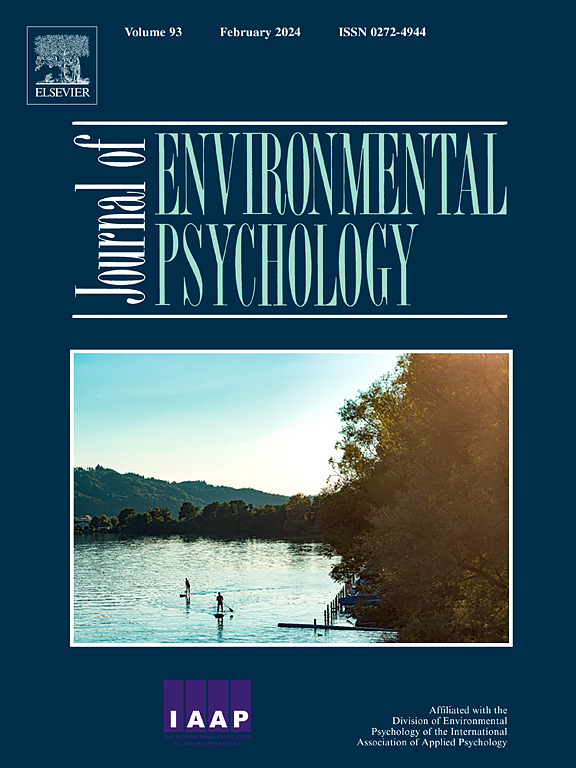自然声音节奏和社会条件对社会互动的影响:一个交互式虚拟实验
IF 6.1
1区 心理学
Q1 ENVIRONMENTAL STUDIES
引用次数: 0
摘要
虽然人们普遍认为自然声音对人类健康有积极影响,但环境心理学对自然声音节奏的影响仍未充分研究,而自然声音节奏是塑造情绪和行为反应的潜在重要因素。本研究采用虚拟场地游览的方法,考察了自然声音的节奏对个体社会互动意愿的影响。场景是在Unity 3D中创建的,结合了城市公园中常见的鸟鸣声和喷泉声等环境声音。参与者自由地探索模拟场所,并与非玩家角色互动,他们的行为被记录下来。他们的个人社会状况、对良好环境的评价和社会互动的意愿通过问卷进行评估。本研究发现,在个人社会条件中高水平的个体中,更快的水声节奏显著增加了社会互动意愿。而鸟鸣节奏的变化对社会交往意愿的影响不显著。社会条件较高的参与者表现出超过11%的社会互动意愿和对声音环境的更积极的评价。这些发现强调了声节奏对社会行为的影响,可能有助于环境心理学的发展,并为城市声景观设计提供实用的见解。本文章由计算机程序翻译,如有差异,请以英文原文为准。
Effects of natural sound tempo and social conditions on social Interaction: An interactive virtual experiment
Although natural sounds are widely known to positively affect human well-being, the influence of natural sound tempo, a potentially significant factor in shaping emotional and behavioral responses, remains underexplored within environmental psychology. This study examines the impact of the tempo of natural sounds on individuals' willingness for social interaction using a virtual site tour approach. Scenarios were created in Unity 3D, incorporating environmental sounds like birdsong and water fountains typically found in urban parks. Participants freely explored the simulated site and interacted with non-player characters, with their behaviors recorded. Their personal social condition, evaluations of the sound environment, and willingness for social interaction were assessed through questionnaires. This study found that faster water sound tempos significantly increased the willingness for social interaction among individuals with medium to high levels of personal social condition. However, changes in birdsong tempo had no significant effect on social interaction willingness. Participants with higher levels of social condition showed over 11 % greater willingness for social interaction and more positive evaluations of the sound environment. These findings highlight the role of sound tempo in influencing social behaviors, which may contribute to the development of environmental psychology and offer practical insights for urban soundscape design.
求助全文
通过发布文献求助,成功后即可免费获取论文全文。
去求助
来源期刊

Journal of Environmental Psychology
Multiple-
CiteScore
10.60
自引率
8.70%
发文量
140
审稿时长
62 days
期刊介绍:
The Journal of Environmental Psychology is the premier journal in the field, serving individuals in a wide range of disciplines who have an interest in the scientific study of the transactions and interrelationships between people and their surroundings (including built, social, natural and virtual environments, the use and abuse of nature and natural resources, and sustainability-related behavior). The journal publishes internationally contributed empirical studies and reviews of research on these topics that advance new insights. As an important forum for the field, the journal publishes some of the most influential papers in the discipline that reflect the scientific development of environmental psychology. Contributions on theoretical, methodological, and practical aspects of all human-environment interactions are welcome, along with innovative or interdisciplinary approaches that have a psychological emphasis. Research areas include: •Psychological and behavioral aspects of people and nature •Cognitive mapping, spatial cognition and wayfinding •Ecological consequences of human actions •Theories of place, place attachment, and place identity •Environmental risks and hazards: perception, behavior, and management •Perception and evaluation of buildings and natural landscapes •Effects of physical and natural settings on human cognition and health •Theories of proenvironmental behavior, norms, attitudes, and personality •Psychology of sustainability and climate change •Psychological aspects of resource management and crises •Social use of space: crowding, privacy, territoriality, personal space •Design of, and experiences related to, the physical aspects of workplaces, schools, residences, public buildings and public space
 求助内容:
求助内容: 应助结果提醒方式:
应助结果提醒方式:


